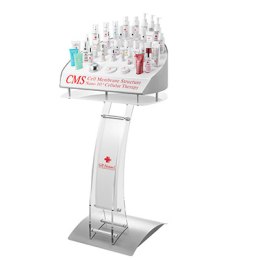Client demand for cosmeceutical skincare to achieve and maintain healthy, youthful-looking skin is insatiable. But without personalised, professional advice, things can go terribly wrong, says Dora Erdossy*.
Without a personalised consultation from an educated skin therapist/clinician, clients can make very poor, even harmful, choices in cosmeceutical skincare, resulting in wasted money and unsatisfactory outcomes.
This is why it is important for us to be knowledgeable and aware of the products and their ingredients that we use to ensure we provide the best solutions for clients.
There has been a lot information given to us about the importance of gut health and its connection with overall health and wellbeing, including the skin.
But as many of us are not nutritionists who can provide appropriate and educated advice about diet and supplements, we can step in and educate clients about the topical use of cosmeceuticals – especially antioxidants – and the importance of them in daily skincare use for a healthy complexion.
We will take a look at some well-known topical antioxidants but first let’s revisit our own innate defence system …
SELF DEFENCE
Our skin being as amazing it is, is armed with elaborate systems of antioxidants (non-enzymes) and enzymes to provide cell protection from the negative effects of free radicals, aka reactive oxygen species (ROS).
The non-enzymatic antioxidants include vitamins A, C and E and they can occupy water- and lipid-soluble cell compartments.
They either prevent free radicals oxidising biological molecules, reduce the formation of free radicals or quench free radicals that have been formed.
Enzymes such as glutathione (GSH), superoxide dismutase (SOD) and catalase protect tissues from ROS.
Enzymes and antioxidants work together to neutralise free radicals and, interestingly, the epidermis has been shown to have higher concentration and activity levels of antioxidants compared to the dermis.
However, with increased oxidative stress due to UV and pollution exposure along with age, antioxidant and enzyme levels can be effected.
That is where topical application of antioxidants come into play as they can help to replenish the natural reservoirs in the skin and have the ability to reduce free radical production.
TOPICAL ANTIOXIDANTS
VITAMIN A is a lipid soluble antioxidant where significant amounts of all-trans-retinol is found in the epidermis.
It cannot be made in the body and hence must be obtained from diet (animal-derived foods such as liver and eggs) or found in precursor form as beta-carotene in vegetables.
Vitamin A is required in the body for a number of biological functions such as vision, bone formation and cell differentiation and growth including skin cells.
Exposure to UVA and UVB can lead to vitamin A deficiency in the skin. There are different forms of vitamin A derivatives used in topical preparations, with retinol being the most frequently used due to its potential of minimal irritation and high stability.
Vitamin A is an antioxidant but is predominantly known for its anti-ageing properties such as increasing the production of extracellular matrix structures such as collagen which in turn increases the thickness of the dermis.
It also helps to reduce the production of collagenase, hence reduces collagen breakdown.
The benefits lead to a diminished appearance of fine lines and wrinkles and an improvement in texture and clarity of the skin.
VITAMIN C is a water-soluble antioxidant and it is the predominant antioxidant in human skin. Humans we are unable to produce vitamin C so it must be obtained from diet, such as citrus fruits.
As it is water-soluble, it functions in the aqueous compartment of the cell and hence protects components within the cell from oxidative stress.
L’ascorbic acid is the most bioactive form of vitamin C and has been found to have a number of benefits for the skin. It:
- Neutralises free radicals as it is an electron donor hence functions well as an antioxidant
- Is essential for collagen production
- Inhibits tyrosinase, hence reduces the appearance of dark spots
- Provides photo-protective effects
VITAMIN E is a major lipid-soluble antioxidant in the body. It is present in a variety of food sources such as nuts, soy and whole-wheat flour.
Alpha-tocopherol is the main active form of vitamin E used in skincare formulations. Its main function is to protect cellular membranes from oxidative stress and it has been shown to have the ability to reduce erythema and oedema brought on by UV exposure and reduce lipid peroxidation.
It has also been shown to improve the visible signs of ageing and improve hydration with topical application.
VITAMIN B3 (niacinamide) is a derivative of niacin; an essential water-soluble vitamin that is obtained through diet such as fish, milk, eggs and nuts.
It is important in a number of cellular metabolic enzyme reactions. The primary form that it is used in skincare formulations is niacinamide and it has been shown to improve skin barrier and texture, reduce redness of the skin, improve fine lines and wrinkles and assist in the reduction of hyperpigmentation and acne.
VITAMIN B5 (panthenol) is a water-soluble vitamin obtained from diet, similar to that of vitamin B3.
When used topically, effects on the skin include improvement of barrier function, increased proliferation of fibroblasts, increases in skin hydration as well as anti-inflammatory benefits.
Enzymatic AntioxidantsSuperoxide Dismutase An important antioxidant which has been shown to convert superoxide free radicals, that are volatile, into oxygen and hydrogen peroxide, which are less volatile.
GLUTATHIONE is another important antioxidant that helps to restore oxidised states of vitamins C and E to a reduced state, enabling them to be active in neutralising free radicals.
There are many active ingredients included in cosmeceutical products that may assist in achieving and maintaining healthy skin for our clients.
Human skin is constantly impacted by ROS from endogenous and exogenous sources which can cause damage to our DNA, lipid membranes and protein structures but may also play a role in accelerating photo-ageing.
As discussed, our skin has its own innate defense system, which can assist in neutralising ROS but when constantly exposed, this elaborate system can become either depleted or overwhelmed hence not able to protect as well as it should.
The use of topical antioxidants has the potential to assist in protecting the skin as well as provide additional benefits.
So let’s educate our clients of these possible benefits and guide them in achieving and maintaining healthy, glowing skin.
 Dora Erdossy is National Trainer (East Coast) for Advanced Cosmeceuticals. ADVANCEDCOSMECEUTICALS.COM.AU
Dora Erdossy is National Trainer (East Coast) for Advanced Cosmeceuticals. ADVANCEDCOSMECEUTICALS.COM.AU
References:
Bissett, D.L. (2009). Common Cosmeceuticals. Clinics in Dermatology, 27, 435-445
Chen, L., Hu, J.Y., & Wang, S.Q. (2012). The role of antioxidants in photoprotection: A critical review. American Academy of Dermatology, 67, 1013-24
Lupo, M.P. (2001). Antioxidants and Vitamins in Cosmetics. Clinics in Dermatology, 19, 467-473
Manela-Azulay, M., & Bagatin, E. (2009). Cosmeceuticals vitamins. Clinics in Dermatology, 27, 469-474
Oresajo, C., Pillai, S., Manco, M., Yatskayer, M., & McDaniel, D. (2012). Antioxidants and the skin: Understanding formulation and efficacy. Dermatologic Therapy, 25, 252-259




